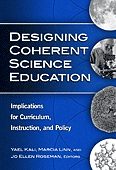Designing Coherent Science Education Looks Toward Students’ Integrated Understanding of Science
New book offers recommendations for curriculum, instruction, and policy
Helping students make sense of the world and understand how science ideas fit together are goals, but not always outcomes, of science education. Learning science is challenging for many, if not most, students, and the strategies and materials used for classroom instruction have often been found lacking. Until now, no clear path to change has emerged.
Last summer some 60 science education scholars and researchers gathered at the Asilomar conference center in Monterey, California, to find common ground on the nature, design, and role of more effective curriculum materials—both print and technology-based—that could make significant and lasting improvements in K-12 science teaching and learning. Their experiences and ideas are captured in Designing Coherent Science Education: Implications for Curriculum, Instruction, and Policy, a new book that offers science educators everywhere a comprehensive look at the state of today’s science curriculum and at the theories, research, and challenges that are driving the field forward.
"This volume is a harbinger for a new approach to improving science education. It is based on the best of a quarter century of curriculum development, improved by designs that are informed by current research, and powered by modern technology."
—From the Foreword by Robert Tinker to Designing Coherent Science Education
"Things are certainly popping in the field of science education. That's why a comprehensive book like this is a must-read for everyone interested in the development of a coherent science curriculum."
—James Trefil, Clarence J. Robinson Professor of Physics, George Mason University, author of Why Science?
A More Coherent Approach
Designing Coherent Science Education is the result of a National Science Foundation-funded collaboration between AAAS’s Center for Curriculum Materials in Science (CCMS) and the Technology Enhanced Learning in Science (TELS) Center at the University of California, Berkeley. The book focuses attention on the interrelated nature of science knowledge and on strategies for supporting learners as they develop their science literacy. Each chapter examines a particular aspect of science education—from the design of curriculum materials and assessments to the preparation of teachers and the support of increasingly diverse student populations—and highlights its role in promoting a more coherent approach to science teaching and learning. Drawing on the relevant research findings of the two Centers, the book proposes principles and criteria that can guide the design and use of more coherent materials and instruction.
As one of the editors of the new volume and director of CCMS, Project 2061’s Jo Ellen Roseman found the collaboration both challenging and rewarding. “Although our two Centers are focused on different science topics and research questions, both CCMS and TELS are concerned with students’ ability to develop an integrated understanding of science and its applications,” Roseman said. “Having to step back from our work and consider what and how to share what we know with others has been an extremely valuable experience for all us.”
Among the book’s chapters are two that include Project 2061 staff as authors. In “Characterizing Curriculum Coherence,” Jo Ellen Roseman and Mary Koppal of Project 2061 along with Marcia Linn, director of the TELS Center at UC Berkeley, lay out the dimensions of curriculum coherence, describe the processes by which learners gain an integrated understanding of science, and review the research approaches taken by each Center. In “Assessing Integrated Understanding of Science,” Project 2061’s deputy director George DeBoer and co-authors Hee-Sun Lee and Freda Husic of TELS use examples from both Centers to consider the design and use of assessment items to measure learning outcomes that are particularly important to an integrated understanding of science.
Designing Coherent Science Education concludes with a chapter of recommendations that emerge from the work of the two Centers. By drawing national attention to curriculum design, education technology, assessment, teacher and leader development, and student diversity, the recommendations aim to promote local, state, and federal policies and practices that will improve the science literacy of all learners.
Read the full text of “Characterizing Curriculum Coherence” [PDF]
Read the full text of “Assessing Integrated Understanding of Science” [PDF]
Designing Coherent Science Education is published by Teachers College Press. See details and ordering information.
# # #
For more information about Project 2061’s contributions to Designing Coherent Science Education, please contact:
Director: Dr. Jo Ellen Roseman, (202) 326-6752
Deputy Director: Dr. George DeBoer, (202) 326-6624
Also in the September/October 2008 issue:





